The Effectiveness of Planning Control on Urban Growth: Evidence from Hangzhou, China
Abstract
:1. Introduction
2. Materials and Methods
2.1. Study Area
2.2. Interpretation of Urban Land Using Remote Sensing Images
2.3. Landscape Metrics of Urban Growth
2.4. Planning Control Effectiveness Index
2.5. Comparison of Context and Objectives for Planning
3. Results
3.1. Spatiotemporal Characteristics of Urban Land Expansion
3.2. Control Effectiveness in the Different Periods of Urban Planning
3.3. Comparison of Plan-Making Logic in Different Periods
4. Discussion
4.1. Historical Features Causing Low-Cost and Unexpected Expansion
4.2. Functional Orientation Driving Fragmented Suburbanization
4.3. Inadequate Methods for Forecasting Population and Land Use Area
4.4. Market Mechanisms Contributing to Inconsistency
4.5. Lack of Support for Polycentricity Development
5. Conclusions and Policy Implications
5.1. Conclusions
5.2. Policy Implications
Acknowledgments
Author Contributions
Conflicts of Interest
References
- Hammer, R.B.; Stewart, S.I.; Winkler, R.L.; Radeloff, V.C.; Voss, P.R. Characterizing dynamic spatial and temporal residential density patterns from 1940–1990 across the North Central United States. Landsc. Urban Plan. 2004, 69, 183–199. [Google Scholar] [CrossRef]
- Martinuzzi, S.; Gould, W.A.; Gonzalez, O.M.R. Land development, land use, and urban sprawl in Puerto Rico integrating remote sensing and population census data. Landsc. Urban Plan. 2007, 79, 288–297. [Google Scholar] [CrossRef]
- Wu, J. Urban ecology and sustainability: The state-of-the-science and future directions. Landsc. Urban Plan. 2014, 125, 209–221. [Google Scholar] [CrossRef]
- Todes, A. Urban growth and strategic spatial planning in Johannesburg, South Africa. Cities 2012, 29, 158–165. [Google Scholar] [CrossRef]
- Hamidi, S.; Ewing, R. A longitudinal study of changes in urban sprawl between 2000 and 2010 in the United States. Landsc. Urban Plan. 2014, 128, 72–82. [Google Scholar] [CrossRef]
- Huang, J.; Lu, X.X.; Sellers, J.M. A global comparative analysis of urban form: Applying spatial metrics and remote sensing. Landsc. Urban Plan. 2007, 82, 184–197. [Google Scholar]
- Wu, W.; Zhao, S.; Zhu, C.; Jiang, J. A comparative study of urban expansion in Beijing, Tianjin and Shijiazhuang over the past three decades. Landsc. Urban Plan. 2015, 134, 93–106. [Google Scholar] [CrossRef]
- Garouani, A.E.; Mulla, D.J.; Garouani, S.E.; Knight, J. Analysis of urban growth and sprawl from remote sensing data: Case of Fez, Morocco. Int. J. Sustain. Built Environ. 2017, in press. [Google Scholar] [CrossRef]
- Hasse, J. Using remote sensing and GIS integration to identify spatial characteristics of sprawl at the building-unit level. In Integration of GIS and Remote Sensing; Mesev, V., Ed.; John Wiley & Sons: Chichester, UK, 2007. [Google Scholar]
- Long, Y.; Han, H.; Tu, Y.; Shu, X. Evaluating the effectiveness of urban growth boundaries using human mobility and activity records. Cities 2015, 46, 76–84. [Google Scholar] [CrossRef]
- Han, H.; Lai, S.K.; Dang, A.; Tan, Z.; Wu, C. Effectiveness of urban construction boundaries in Beijing: An assessment. J. Zhejiang Univ. Sci. A 2009, 10, 1285–1295. [Google Scholar] [CrossRef]
- Hai, M.P.; Yamaguchi, Y.; Bui, T.Q. A case study on the relation between city planning and urban growth using remote sensing and spatial metrics. Landsc. Urban Plan. 2011, 100, 223–230. [Google Scholar]
- Gennaio, M.P.; Hersperger, A.M.; Bürgi, M. Containing urban sprawl—Evaluating effectiveness of urban growth boundaries set by the Swiss Land Use Plan. Land Use Policy 2009, 26, 224–232. [Google Scholar] [CrossRef]
- Schneider, A.; Chang, C.; Paulsen, K. The changing spatial form of cities in Western China. Landsc. Urban Plan. 2015, 135, 40–61. [Google Scholar] [CrossRef]
- Wei, Y.P.; Zhao, M. Urban spill over vs. local urban sprawl: Entangling land-use regulations in the urban growth of China’s megacities. Land Use Policy 2009, 26, 1031–1045. [Google Scholar]
- Torrens, P.M. A toolkit for measuring sprawl. Appl. Spat. Anal. Policy 2008, 1, 5–36. [Google Scholar] [CrossRef]
- Mubareka, S.; Koomen, E.; Estreguil, C.; Lavalle, C. Development of a composite index of urban compactness for land use modelling applications. Landsc. Urban Plan. 2011, 103, 303–317. [Google Scholar] [CrossRef]
- Wu, K.Y.; Zhang, H. Land use dynamics, built-up land expansion patterns, and driving forces analysis of the fast-growing Hangzhou metropolitan area, eastern China (1978–2008). Appl. Geogr. 2012, 34, 137–145. [Google Scholar] [CrossRef]
- Yue, W.; Liu, Y.; Fan, P. Measuring urban sprawl and its drivers in large Chinese cities: The Case of Hangzhou. Land Use Policy 2013, 31, 358–370. [Google Scholar] [CrossRef]
- Wei, Y.D.; Ye, X. Urbanization, land use, and sustainable development in China. Stoch. Environ. Res Risk Assess. 2014, 28, 757–765. [Google Scholar] [CrossRef]
- Weilenmann, B.; Seidl, I.; Schulz, T. The socio-economic determinants of urban sprawl between 1980 and 2010 in Switzerland. Landsc. Urban Plan. 2017, 157, 468–482. [Google Scholar] [CrossRef]
- Kline, J.D.; Thiers, P.; Ozawa, C.P.; Yeakley, J.A.; Gordon, S.N. How well has land-use planning worked under different governance regimes? A case study in the Portland, OR-Vancouver, WA metropolitan area, USA. Landsc. Urban Plan. 2014, 131, 51–63. [Google Scholar] [CrossRef]
- Sharifi, A.; Chiba, Y.; Okamoto, K.; Yokoyama, S.; Murayama, A. Can master planning control and regulate urban growth in Vientiane, Laos? Landsc. Urban Plan. 2014, 131, 1–13. [Google Scholar] [CrossRef]
- Yeh, A.G.O. Dual land market and internal spatial structure of Chinese cities. In Restructuring the Chinese City: Changing Society, Economy and Space; Ma, L.J., Wu, F., Eds.; Routledge: London, UK, 2005. [Google Scholar]
- Qi, Y.; Yang, Y.; Jin, F. China’s economic development stage and its spatiotemporal evolution: A prefectural-level analysis. J. Geogr. Sci. 2013, 23, 297–314. [Google Scholar] [CrossRef]
- Garau, C.; Zamperlin, P.; Balletto, G. Reconsidering the Geddesian Concepts of Community and Space through the Paradigm of Smart Cities. Sustainability 2016, 8, 985. [Google Scholar] [CrossRef]
- Du, J.; Thill, J.C.; Peiser, R.B.; Feng, C. Urban land market and land-use changes in post-reform China: A case study of Beijing. Landsc. Urban Plan. 2014, 124, 118–128. [Google Scholar] [CrossRef]
- Tao, R.; Su, F.; Liu, M.; Cao, G. Land leasing and local public finance in China’s regional development: Evidence from prefecture-level cities. Urban Stud. 2010, 47, 2217–2236. [Google Scholar]
- Tian, L.; Ge, B.; Li, Y. Impacts of state-led and bottom-up urbanization on land use change in the peri-urban areas of Shanghai: Planned growth or uncontrolled sprawl? Cities 2017, 476–486. [Google Scholar] [CrossRef]
- Thiers, P.; Stephan, M.; Walker, A. Differences in Regime and Structure within an Ecological Region: Comparing Environmental Governance in the Portland-Vancouver Metropolitan Area. In Proceedings of the 2011 Annual Meeting of the American Political Science Association, Seattle, WA, USA, 1–4 September 2011; SSRN: Rochester, NY, USA, 2011. [Google Scholar]
- Qian, H.; Wong, C. Master planning under urban-rural integration: The case of Nanjing, China. Urban Policy Res. 2012, 30, 403–421. [Google Scholar] [CrossRef]
- Xie, H.; Wang, W. Exploring the Spatial-Temporal Disparities of Urban Land Use Economic Efficiency in China and Its Influencing Factors under Environmental Constraints Based on a Sequential Slacks-Based Mode. Sustainability 2015, 7, 10171–10190. [Google Scholar] [CrossRef]
- Xie, H.; He, Y.; Xie, X. Exploring the factors influencing ecological land change for China’s Beijing-Tianjin-Hebei region using big data. J. Clean. Prod. 2017, 142, 677–687. [Google Scholar] [CrossRef]
- Zhao, P.; Lü, B.; Johan, W. Conflicts in urban fringe in the transformation era: An examination of performance of the metropolitan growth management in Beijing. Habitat Int. 2009, 33, 347–356. [Google Scholar] [CrossRef]
- Cheng, J.Q.; Turkstra, J.; Peng, M.J.; Du, N.; Ho, P. Urban land administration and planning in China: Opportunities and constraints of spatial data models. Land Use Policy 2006, 23, 604–616. [Google Scholar] [CrossRef]
- Wu, J.; Hobbs, R. Key issues and research priorities in landscape ecology: An idiosyncratic synthesis. Landsc. Ecol. 2002, 17, 355–365. [Google Scholar] [CrossRef]
- Feng, J.; Chen, Y. Spatiotemporal evolution of urban form and land-use structure in Hangzhou, China: Evidence from fractals. Environ. Plann. B Plann. Des. 2010, 37, 838–856. [Google Scholar] [CrossRef]
- Wang, J.; Cheng, Q.; Chen, J.A. GIS and remote sensing-based analysis of land use change using the asymmetric relation analysis method: A case study from the city of Hangzhou, China. Math. Geosci. 2011, 43, 435–453. [Google Scholar] [CrossRef]
- Liu, Z.; He, C.; Zhang, Q.; Huang, Q.; Yang, Y. Extracting the dynamics of urban expansion in China using DMSP-OLS nighttime light data from 1992 to 2008. Landsc. Urban Plan. 2012, 106, 62–72. [Google Scholar] [CrossRef]
- Taubenböck, H.; Wiesner, M.; Felbier, A.; Marconcini, M.; Esch, T.; Dech, S. New dimensions of urban landscapes: The spatio-temporal evolution from a polynuclei area to a mega-region based on remote sensing data. Appl. Geogr. 2014, 47, 137–153. [Google Scholar] [CrossRef]
- Zhu, J. Local developmental state and order in China’s urban development during transition. Int. J. Urban Reg. Res. 2004, 28, 424–447. [Google Scholar] [CrossRef]
- Schwarz, N. Urban form revisited—Selecting indicators for characterising European cities. Landsc. Urban Plan. 2010, 96, 29–47. [Google Scholar] [CrossRef]
- Kuang, W.; Chi, W.; Lu, D.; Dou, Y. A comparative analysis of megacity expansions in China and the US: Patterns, rates and driving forces. Landsc. Urban Plan. 2014, 132, 121–135. [Google Scholar] [CrossRef]
- Liu, Y.; Yue, W.; Fan, P.; Song, Y. Suburban residential development in the era of market-oriented land reform: The case of Hangzhou, China. Land Use Policy 2015, 42, 233–243. [Google Scholar] [CrossRef]
- Zhu, Q. Hangzhou. Cities 2015, 48, 42–54. [Google Scholar]
- McGarigal, K.; Cushman, S.A.; Ene, E. FRAGSTATS v4: Spatial Pattern Analysis Program for Categorical and Continuous Maps. Available online: http://www.umass.edu/landeco/research/fragstats/fragstats.html (accessed on 15 January 2016).
- Yu, X.J.; Ng, C.N. Spatial and temporal dynamics of urban sprawl along two urban-rural transects: A case study of Guangzhou, China. Landsc. Urban Plan. 2007, 79, 96–109. [Google Scholar] [CrossRef]
- Li, Y.; Zhu, X.; Sun, X.; Wang, F. Landscape effects of environmental impact on bay-area wetlands under rapid urban expansion and development policy: A case study of Lianyungang, China. Landsc. Urban Plan. 2010, 94, 218–227. [Google Scholar] [CrossRef]
- Kaza, N. The changing urban landscape of the continental United States. Landsc. Urban Plan. 2013, 110, 74–86. [Google Scholar] [CrossRef]
- Ma, L.J.C. Urban transformation in China, 1949–2000: A review and research agenda. Environ. Plan. A 2001, 34, 1545–1569. [Google Scholar] [CrossRef]
- Qian, Y.Y.; Weingast, B.R. China’s transition to markets: Market-preserving federalism, Chinese style. J. Policy Reform 1996, 1, 149–185. [Google Scholar] [CrossRef]
- Xie, H.; Wang, W.; Yang, Z.; Choi, Y. Measuring the sustainable performance of industrial land utilization in major industrial zones of China. Technol. Forecast. Soc. Chang. 2016, 112, 207–219. [Google Scholar] [CrossRef]
- Yeh, A.G.; Wu, F. The transformation of the urban planning system in China from a centrally-planned to transitional economy. Prog. Plan. 1999, 51, 167–252. [Google Scholar]
- Seto, K.C.; Fragkias, M. Quantifying spatiotemporal patterns of urban land-use change in four cities of China with time series landscape metrics. Landsc. Ecol. 2005, 20, 871–888. [Google Scholar] [CrossRef]
- Luo, X.; Shen, J. Why city-region planning does not work well in China the case of Suzhou-Wuxi-Changzhou. Cities 2008, 25, 207–217. [Google Scholar] [CrossRef]
- Su, S.; Liu, Z.; Xu, Y.; Li, J.; Pi, J. China’s megaregion policy: Performance evaluation framework, empirical findings and implications for spatial polycentric governance. Land Use Policy 2017, 63, 1–19. [Google Scholar] [CrossRef]
- Zhang, Q.; Su, S. Determinants of urban expansion and their relative importance: A comparative analysis of 30 major metropolitans in China. Habitat Int. 2016, 58, 89–107. [Google Scholar] [CrossRef]
- Su, S.; Jiang, Z.; Zhang, Q.; Zhang, Y. Transformation of agricultural landscapes under rapid urbanization: A threat to sustainability in Hang-Jia-Hu region, China. Appl. Geogr. 2011, 31, 439–449. [Google Scholar] [CrossRef]
- Su, S.; Hu, Y.; Luo, F.; Mai, G.; Wang, Y. Farmland fragmentation due to anthropogenic activity in rapidly developing region. Agric. Syst. 2014, 131, 87–93. [Google Scholar] [CrossRef]
- You, H. Quantifying megacity growth in response to economic transition: A case of Shanghai, China. Habitat Int. 2016, 53, 115–122. [Google Scholar] [CrossRef]
- You, H. Agricultural landscape dynamics in response to economic transition: Comparisons between different spatial planning zones in Ningbo region, China. Land Use Policy 2017, 61, 316–328. [Google Scholar] [CrossRef]
- You, H. Quantifying the coordinated degree of urbanization in Shanghai, China. Qual. Quant. 2016, 50, 1273–1283. [Google Scholar] [CrossRef]
- Wen, H.; Zhang, Y.; Zhang, L. Assessing amenity effects of urban landscapes on housing price in Hangzhou, China. Urban For. Urban Green. 2015, 14, 1017–1026. [Google Scholar] [CrossRef]
- Yao, G.; Xie, H. Rural spatial restructuring in ecologically fragile mountainous areas of southern China: A case study of Changgang Town, Jiangxi Province. J. Rural Stud. 2016, 47, 435–448. [Google Scholar] [CrossRef]
- Burger, M.; Meijers, E. Form follows function? Linking morphological and functional polycentricity. Urban Stud. 2012, 49, 1127–1149. [Google Scholar] [CrossRef]
- Lu, D.S.; Weng, Q.H. Spectral mixture analysis of the urban landscape in Indianapolis with landsat etm plus imagery. Photogramm. Eng. Remote Sens. 2004, 70, 1053–1062. [Google Scholar] [CrossRef]
- Masek, J.G.; Lindsay, F.E.; Goward, S.N. Dynamics of urban growth in the Washington DC metropolitan area, 1973–1996, from landsat observations. Int. J. Remote Sens. 2000, 21, 3473–3486. [Google Scholar] [CrossRef]
- Huang, S.L.; Wang, S.H.; William, W.B. Sprawl in Taipei’s peri-urban zone: Responses to spatial planning and implications for adapting global environmental change. Landsc. Urban Plan. 2009, 90, 20–32. [Google Scholar] [CrossRef]
- Hossein, S.M.; Marco, H. Spatiotemporal variability of urban growth factors: A global and local perspective on the megacity of Mumbai. Int. J. Appl. Earth Obs. Geoinf. 2015, 35, 187–198. [Google Scholar]
- Xie, H.; Yafen, H.E.; Zou, J.; Qun, W. Spatio-temporal difference analysis of cultivated land use intensity based on emergy in the Poyang Lake Eco-economic Zone of China. J. Geogr. Sci. 2016, 26, 1412–1430. [Google Scholar] [CrossRef]
- Xie, H.; Yao, G.; Liu, G. Spatial evaluation of the ecological importance based on GIS for environmental management: A case study in Xingguo county of China. Ecol. Indic. 2015, 51, 3–12. [Google Scholar] [CrossRef]
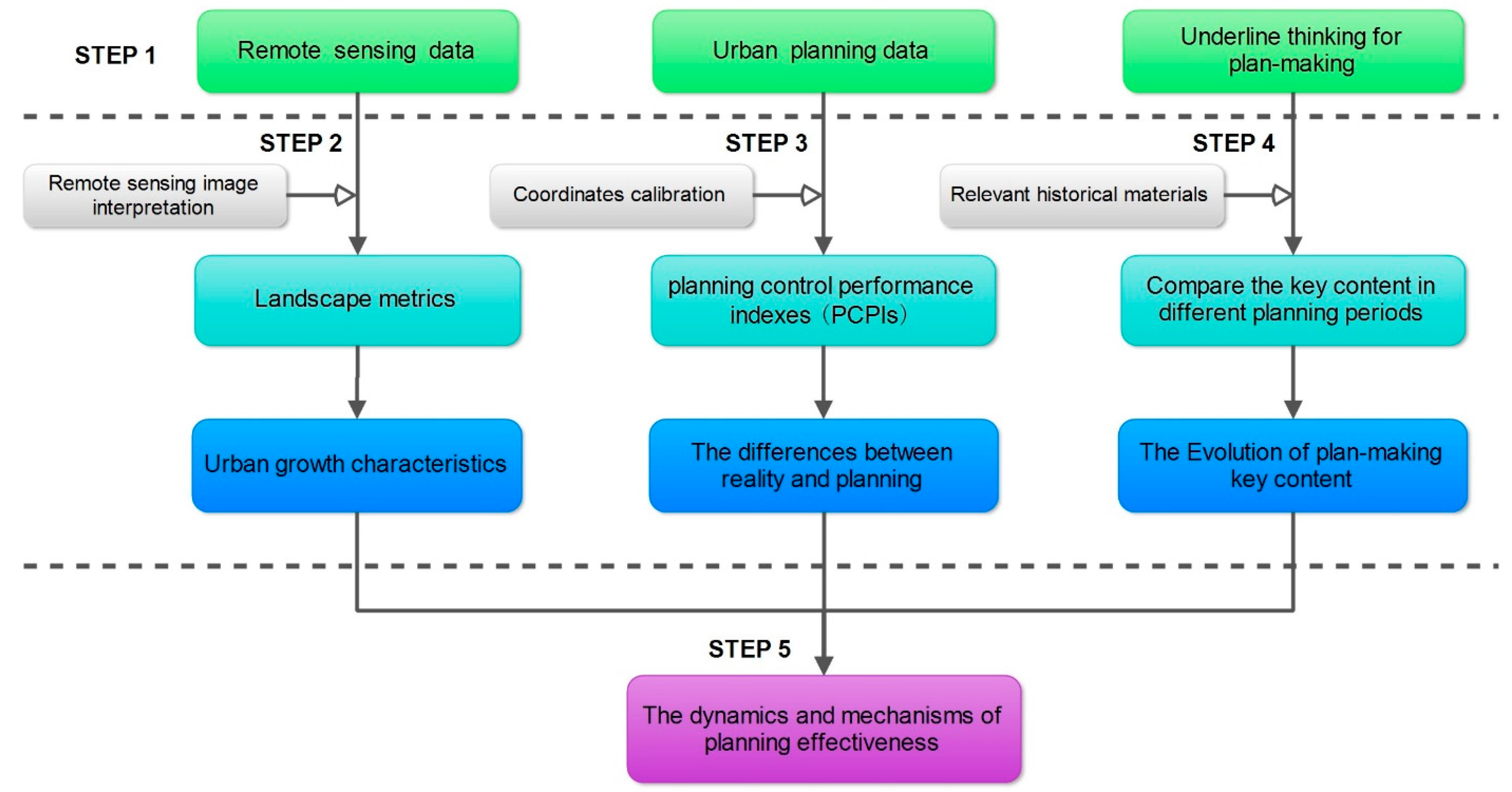

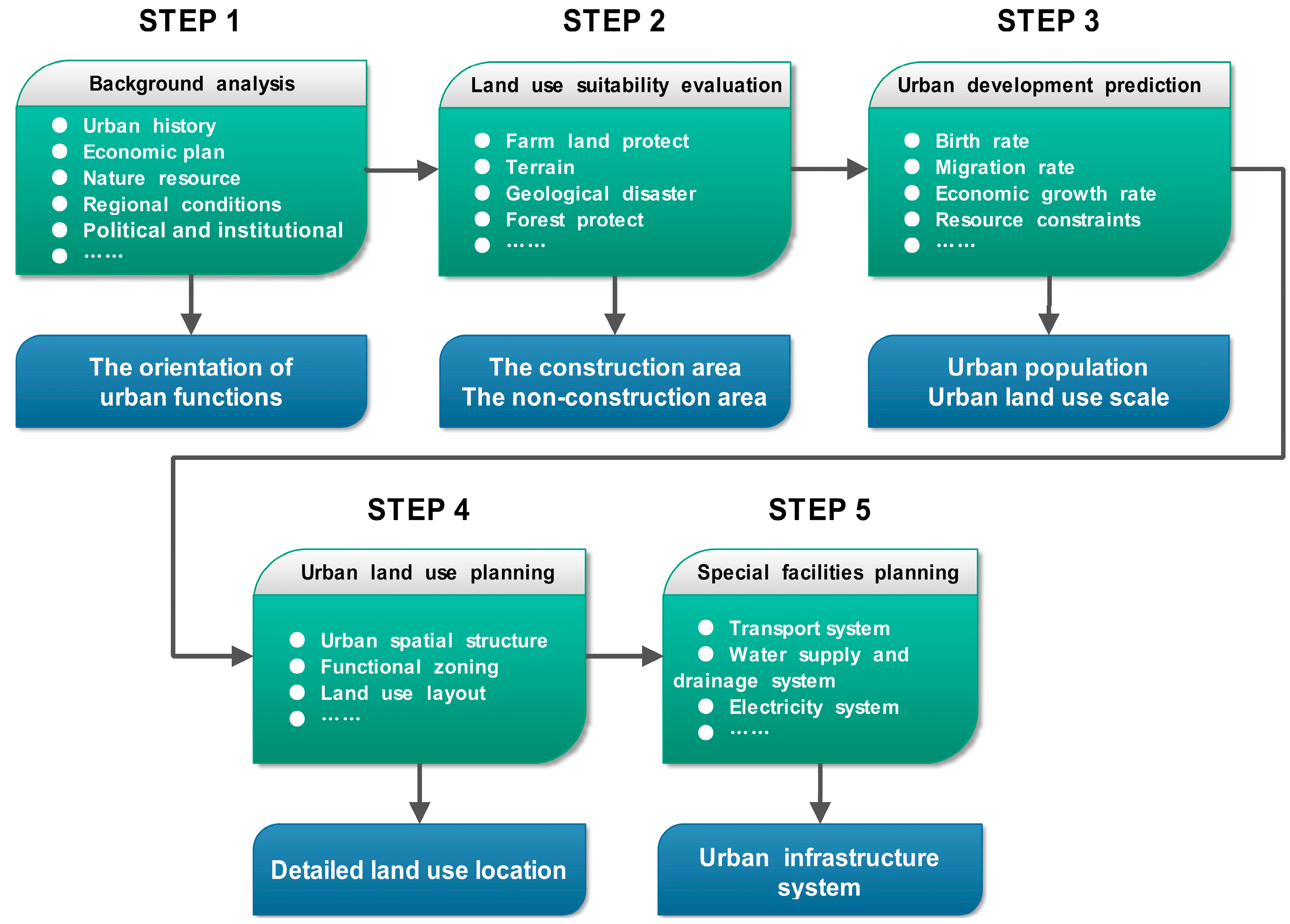
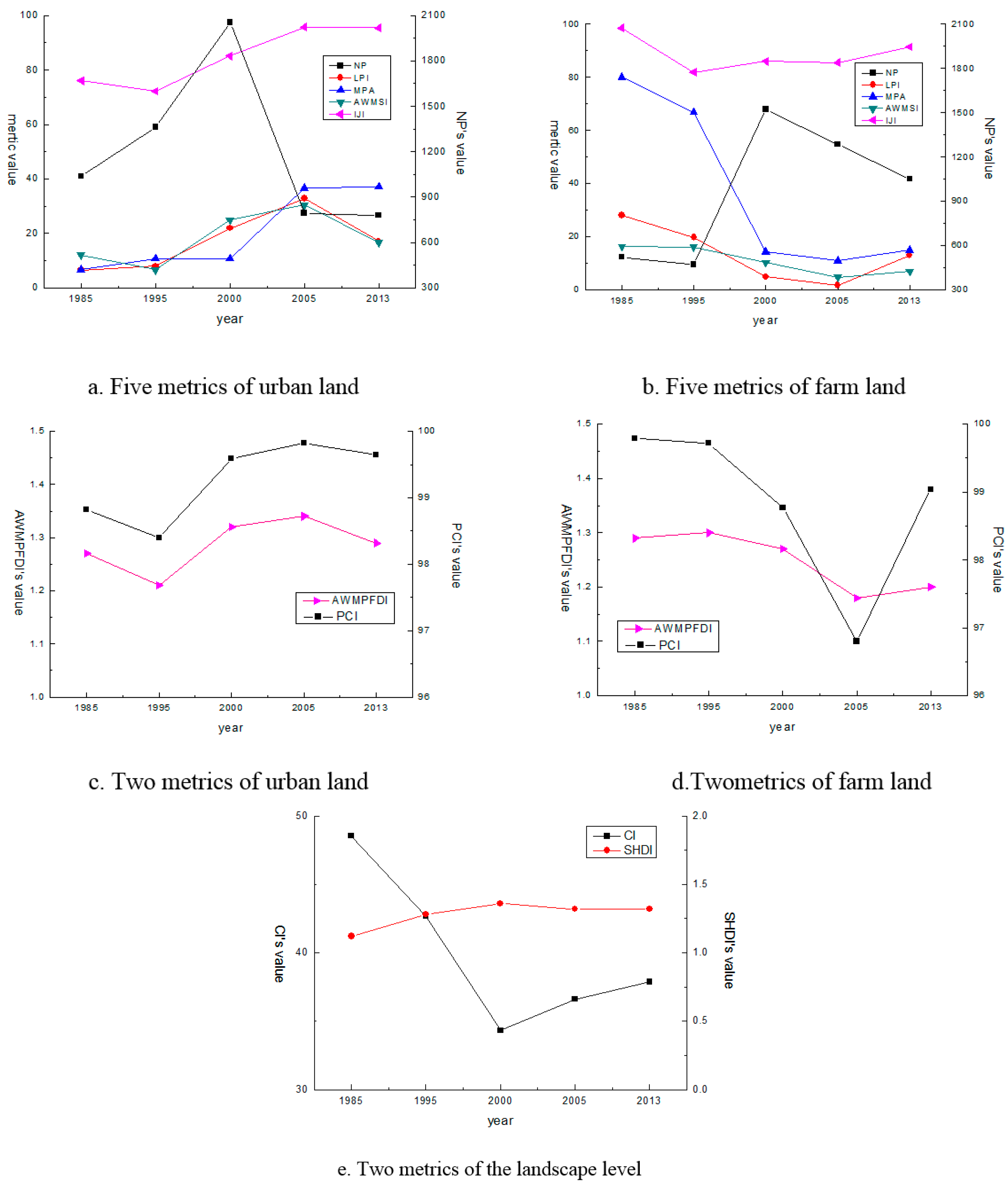
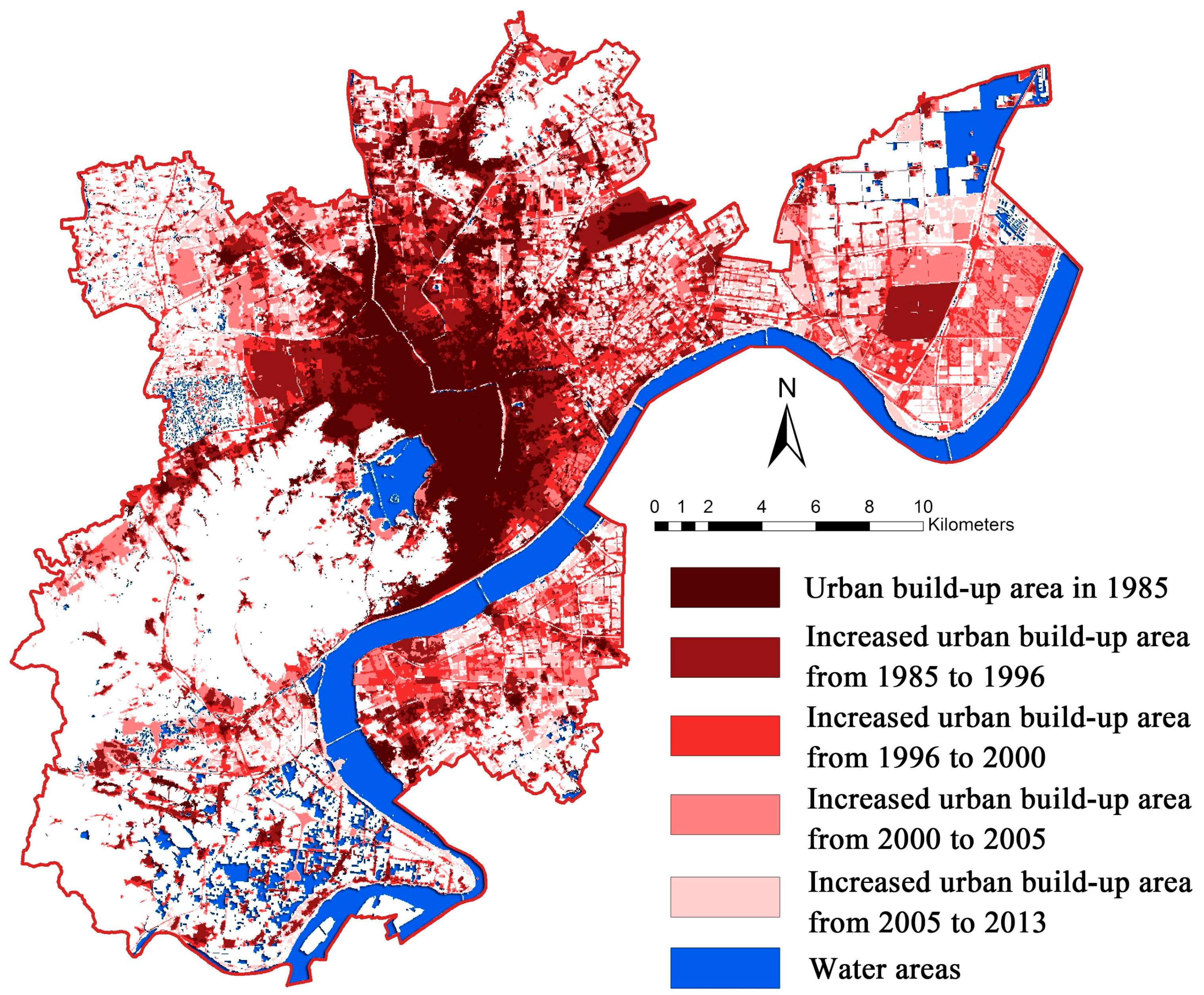
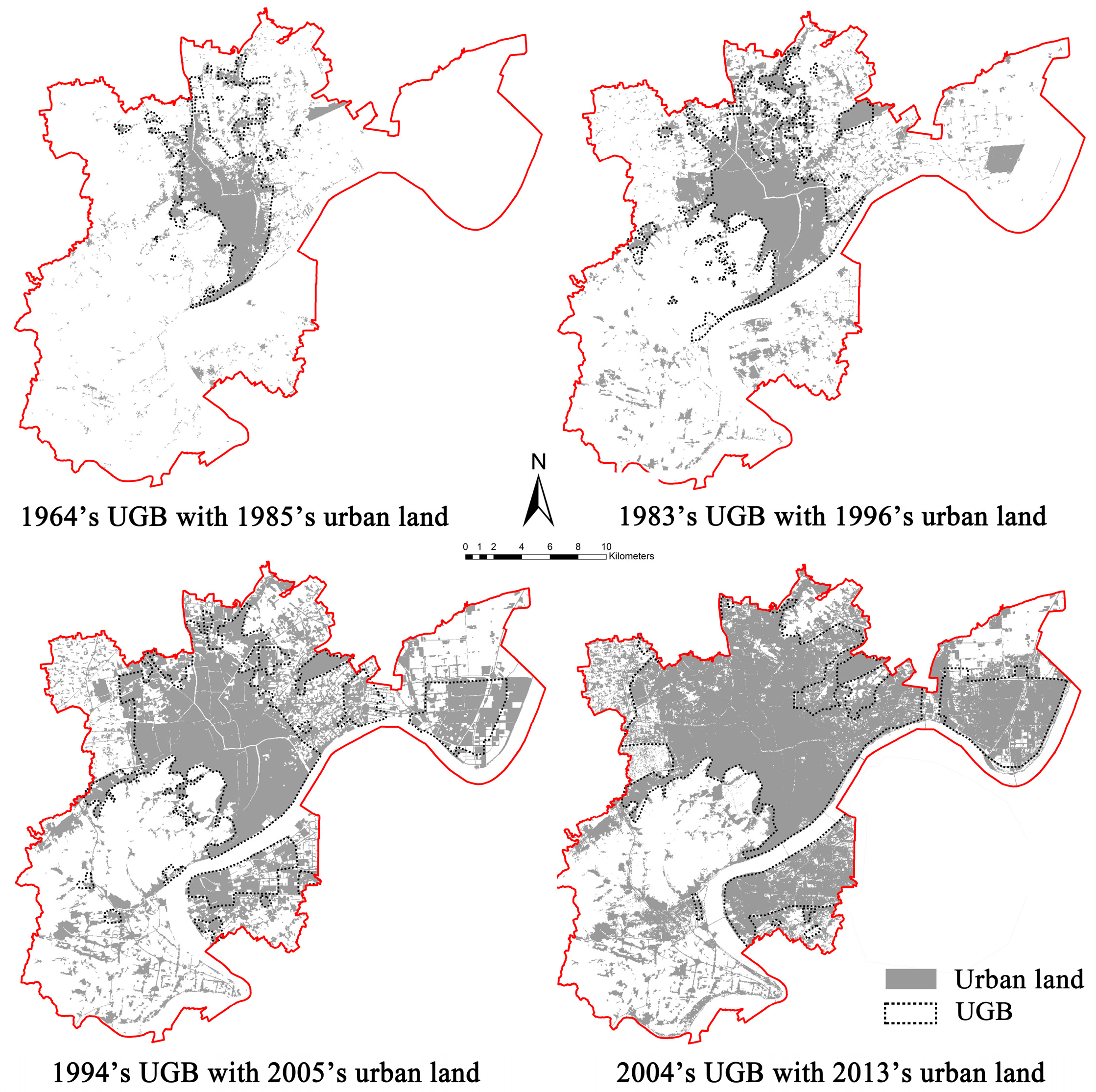
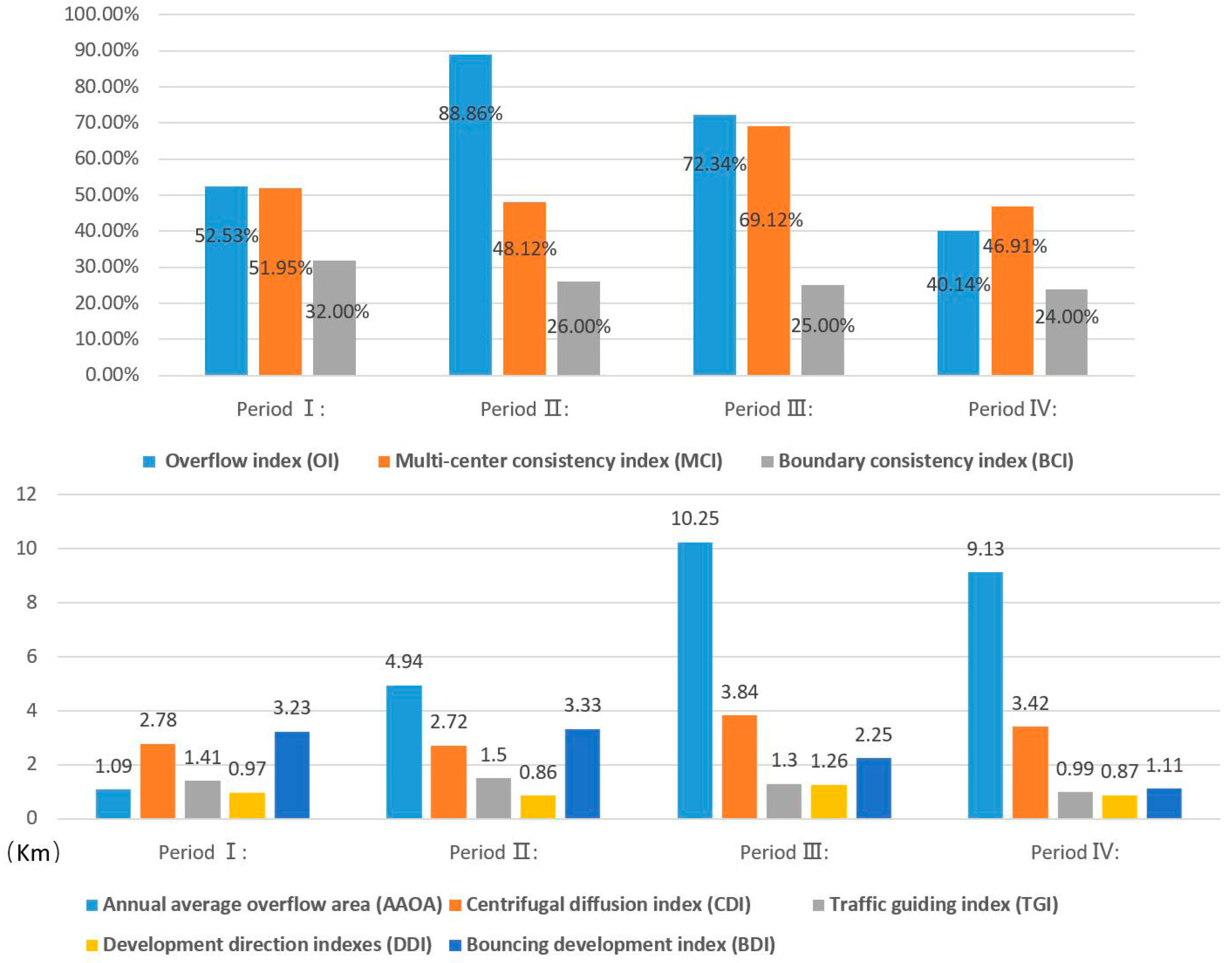
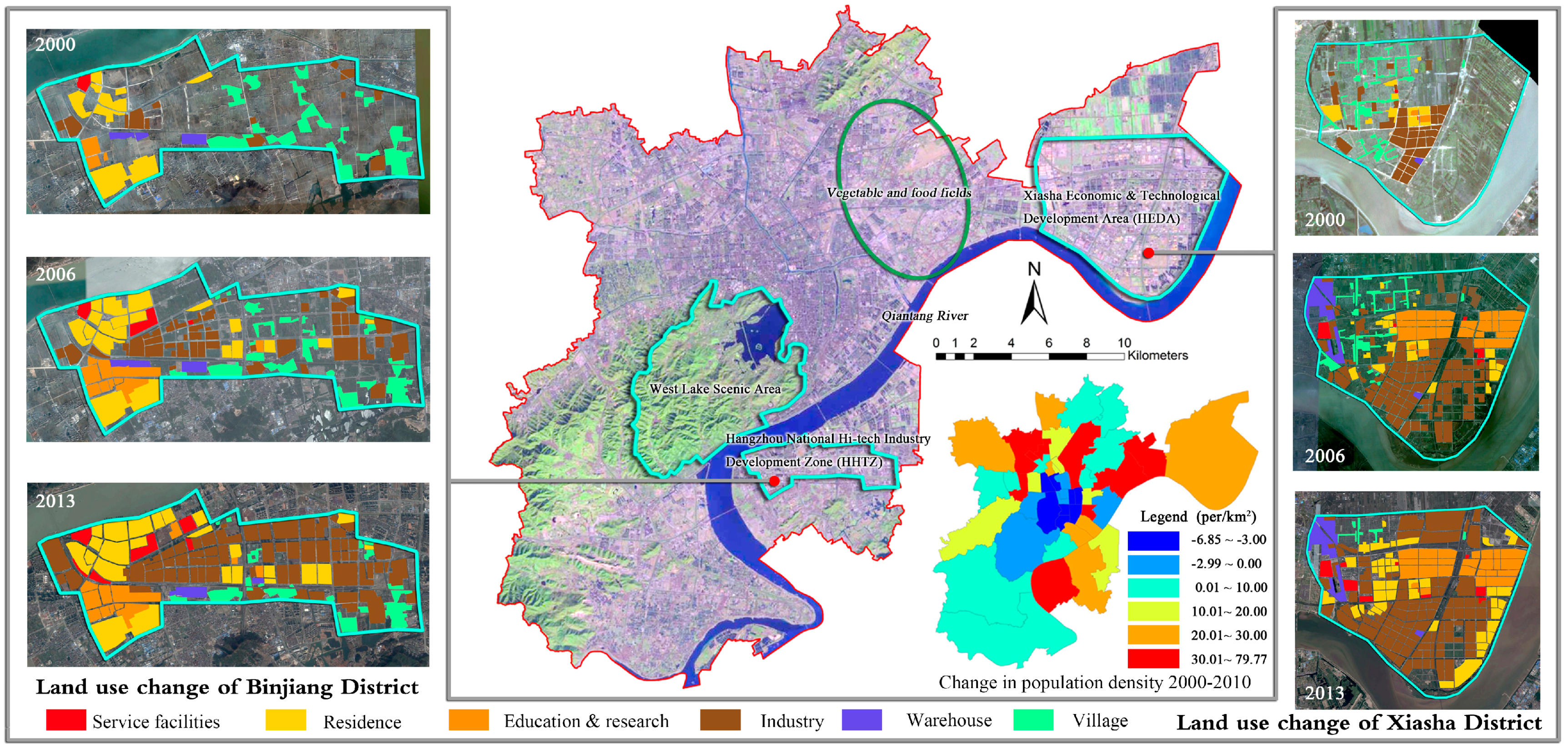


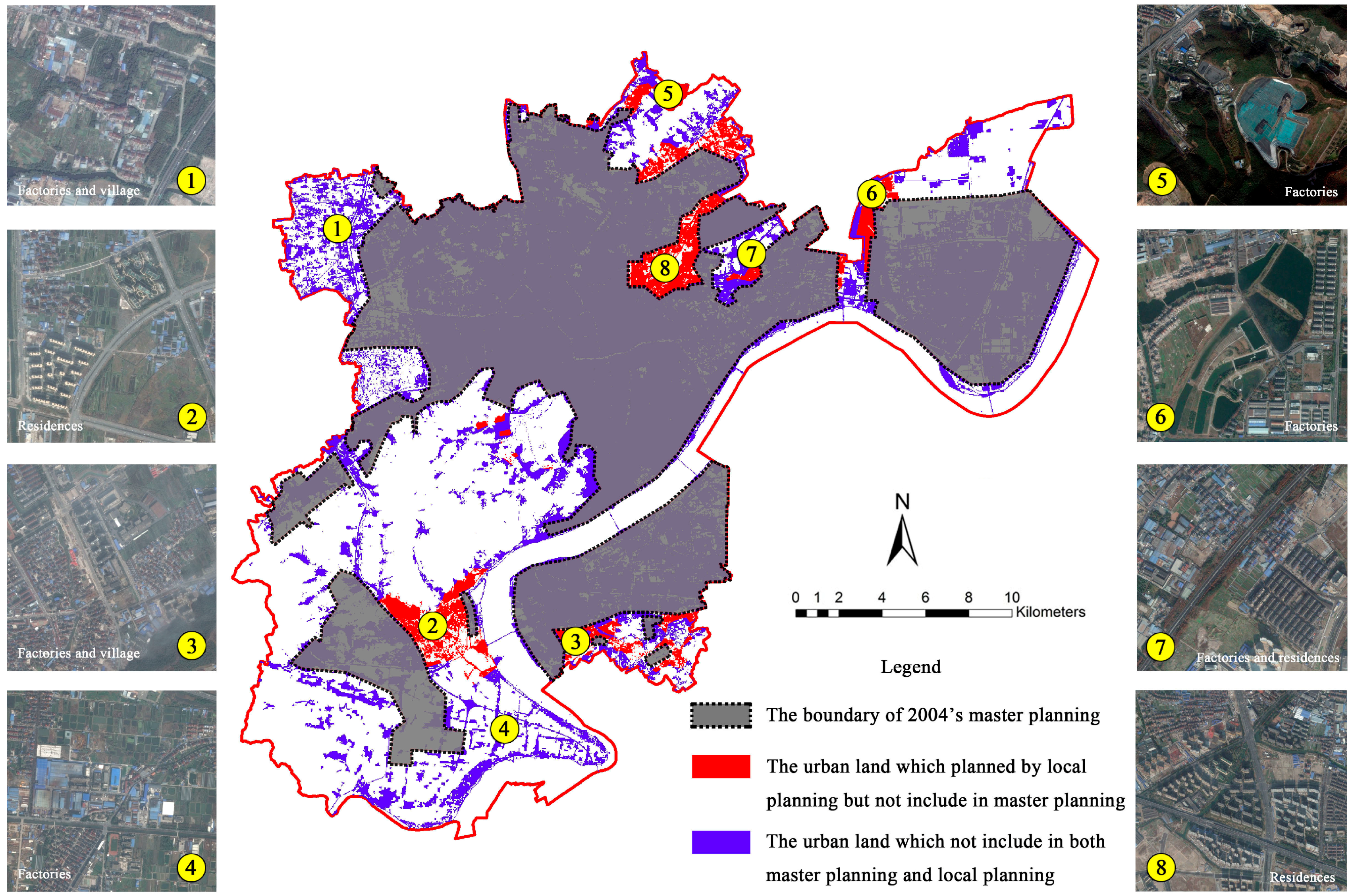
| System | Satellite | Path/Row | Date of Acquisition | Band | Spatial Resolution (Pixel Size—Meters) |
|---|---|---|---|---|---|
| Landsat TM | Landsat-5 | P119/R39 | 11 January 1985 | 1, 2, 3, 4, 5, 7 | 30 |
| Landsat TM | Landsat-5 | P119/R39 | 9 December 1995 | 1, 2, 3, 4, 5, 7 | 30 |
| Landsat ETM+ | Landsat-7 | P119/R39 | 4 May 2000 | 1, 2, 3, 4, 5, 7 | 30 |
| Landsat ETM+ | Landsat-7 | P119/R39 | 17 October 2005 | 1, 2, 3, 4, 5, 7 | 30 |
| Landsat OLI | Landsat-8 | P119/R39 | 19 July 2013 | 2, 3, 4, 5, 6, 7 | 30 |
| Index | Formula | Level | Purpose of Use |
|---|---|---|---|
| Number of Patches (NP) | Class level | Measuring fragmentation | |
| Mean Patch Area (MPA) | Class level | Measuring fragmentation | |
| Largest Patch Index (LPI) | Class level | Measuring dominance | |
| Area-Weight Mean Shape Index (AWMSI) | Class level | Measuring fragmentation | |
| AreaWeight Mean Patch Fractal Dimension Index (AWMPFDI) | Class level | Measuring fragmentation | |
| Interspersion and Juxtaposition Index (IJI) | Class level | Measuring aggregation | |
| Patch Cohesion Index (PCI) | Class level | Measuring connectivity | |
| Contagion Index (CI) | Landscape level | Measuring aggregation | |
| Shannon’s Diversity Index (SHDI) | Landscape level | Measuring diversity |
| Assessment Dimensions | Index | Formation and Note | Description |
|---|---|---|---|
| The control effect of spatial scale | Overflow index (OI) | OI is used to measure the control effectiveness of the spatial scale, and greater is the value of OI, more effective is the urban planning control measure [11]. | |
| ai is the ith urban land patch area inside the planned districts, bj is the jth urban land patch area outside the planned districts. (i = 1, 2, 3, …, m), (j = 1, 2, 3, …, n) | |||
| Annual average overflow area (AAOA) | AAOA is used to measure the control effectiveness of the spatial scale like OI, and greater is the value of OI, worse is the urban planning control effect. | ||
| bi is the ith urban land patch area outside the planned districts, myear is the planning period. (i = 1, 2, 3, …, n) | |||
| The control effect of spatial structure | Multi-centerconsistency index (MCI) | MCI is used to the control effectiveness of the spatial structure. Higher MCI indicates that the planning control of the urban spatial structure is more effective. | |
| aij is the jth urban land patch area inside the planned districts in the ith group, bi is the total urban land area of the ith group, m is the number of groups. (i = 1, 2, 3, …, m), (j = 1, 2, 3, …, n) | |||
| Centrifugal diffusion index(CDI) | CDI is used to the control effectiveness of the spatial structure. Higher is the value of CDI, more effective is the planning control effectiveness of the urban spatial structure. | ||
| (xi, yi) is the geographic center of the ith urban land patch, (xj, yj) is the geographic center of the planning urban land patch, (xo, yo) is the geographic center of the total urban land, m is the number of geographic centers of urban land patches, n is the number of geographic centers of the planning urban land patches. (i = 1, 2, 3, …, m), (j = 1, 2, 3, …, n) | |||
| Traffic guiding index (TGI) | TDI is used to the control effectiveness of the spatial structure and clarify the influences of the planning transport facilities on urban sprawl. Smaller is the value of TDI, more effective is the planning control effectiveness of the urban spatial structure. | ||
| (xi, yi) is the geographic center of the ith urban land patch, (xj, yj) is the coordinate of the major road, az is the parameter of the major road, n is the number of geographic centers of urban land patches. (i = 1, 2, 3, …, n), (z = 1, 2, 3, …, m) | |||
| The control effect of spatial pattern | Development direction indexes (DDI) | (notes of deviation orientation) | DDI is used to the control effectiveness of the spatial pattern. It reflects the accuracy of the planning’s prediction on urbanization. |
| (x1, y1) is the geographic center of the total urban land, (x2, y2) is the geographic center of the planning urban land. | |||
| Bouncing development index (BDI) | BDI is used to the control effectiveness of the spatial pattern. It reflects the planning control effects on the compactness of the urban development. Lower is BDI, higher is the efficiency of the planning control. | ||
| (xi, yi) is the geographic center of the ith urban land patch outside the planned districts, (xj, yj) is the coordinate of the planning boundary, az is the parameter of the planning boundary, n is the number of geographic centers of urban land patches outside the planned districts. (i = 1, 2, 3, …, n), (z = 1, 2, 3, …, m) | |||
| Boundary consistency index (BCI) | BCI is used to the control effectiveness of the spatial pattern. Higher is BCI, higher is the efficiency of the planning control [11]. | ||
| L1 is the length of coincidence lines of urban land patches and the planning urban land patches; L2 is the length of the planning boundary. |
| Land Classification | 1985 | 1995 | 2000 | 2005 | 2013 | |||||
|---|---|---|---|---|---|---|---|---|---|---|
| Area (km2) | Ratio (%) | Area (km2) | Ratio (%) | Area (km2) | Ratio (%) | Area (km2) | Ratio (%) | Area (km2) | Ratio (%) | |
| Urban land | 69.54 | 9.85 | 146.9 | 20.80 | 223.2 | 31.60 | 293.07 | 41.50 | 318.72 | 45.13 |
| Farm land | 417.58 | 59.13 | 315.85 | 44.72 | 216.92 | 30.72 | 140.25 | 19.86 | 163.39 | 23.14 |
| Other lands (including water, forest, bare land, rural land, etc.) | 219.11 | 31.03 | 243.48 | 34.48 | 266.11 | 37.68 | 272.91 | 38.64 | 224.12 | 31.73 |
| Dimensions | Spatial Index of Planning Control Effectiveness | Period I: 1964–1985 | Period II: 1983–1995 | Period III: 1994–2005 | Period IV: 2004–2013 |
|---|---|---|---|---|---|
| The control effect of spatial scale | Overflow index (OI) | 52.53% | 88.86% | 72.34% | 40.14% |
| Annual average overflow area (AAOA) | 1.09 km2 | 4.94 km2 | 10.25 km2 | 9.13 km2 | |
| The control effect of spatial structure | Multi-center consistency index (MCI) | 51.95% | 48.12% | 69.12% | 46.91% |
| Centrifugal diffusion index (CDI) | 2782.93 m | 2723.27 m | 3844.82 m | 3423.02 m | |
| Traffic guiding index (TGI) | 1.41 km | 1.50 km | 1.30 km | 0.99 km | |
| The control effect of spatial pattern | Development direction indexes (DDI) | 974.18 m | 860.25 m | 1262.71 m | 872.43 m |
| Southeast | Southeast | Southwest | Southeast | ||
| Bouncing development index (BDI) | 3233.55 m | 3329.88 m | 2250.85 m | 1114.66 m | |
| Boundary consistency index (BCI) | 0.32 | 0.26 | 0.25 | 0.24 |
| Planning | Political and Economic Background | Planned Urban Population | Planned Urban Development Land Area | Functional Orientation | Key Focus of Spatial Layout | ||
|---|---|---|---|---|---|---|---|
| Population (Million) | Year for Predict | Land use Area (km2) | Year for Predict | ||||
| 1964 Master Plan (The forward period 1984) | The Great Leap Forward; Planned economy system; “the Great Cultural Revolution” | 0.80 | 1984 | 70 | 1984 | An industrial city and tourist city | Develop northward; build new urban center (Wulin CBD); Industries development in suburban. |
| 1983 Master Plan (The recent period 1985, The forward period 2000) | Since the reform and opening up, the planned economy system transformed to the market economy system | 1.13 1.15 (planned) 1.20 (planned) | 1981 1985 2000 | 102 111 (planned) 139 (planned) | 1981 1985 2000 | Provincial capital, famous historic and cultural city, National key scenic tourist city | Protect the West Lake; Build new urban center (Qianjiang CBD); Old city reconstruction; Outsourcing industries; develop satellite town. |
| 1994 Master Plan (The recent period 2000, The forward period 2010) | The planned economy system transformed to the market economy system (included land institutions reform) | 1.41 1.68 (planned) 2.08 (planned) | 1994 2000 2010 | No data 126 (planned) 156 (planned) | 1994 2000 2010 | International key scenic tourist city, famous historic and cultural city, important center city of Yangtze river delta, Provincial capital (Economic and cultural science and education center) | Focus on developing the third industry district; Develop northward and southward; Polycentric development and cross river development |
| 2004 Master Plan (The recent period 2010, The forward period 2020) | The planned economy system transformed to the market economy system, participate in WTO | 1.81 2.21 (planned) 2.45 (planned) | 2001 2010 2020 | 150.95 189.15 (planned) 221.48 (planned) | 2001 2010 2020 | Important center city of Yangtze river delta, Provincial capital (Economic and cultural science and education center), International key scenic tourist city, famous historic and cultural city | Major city and subcenters (Xiasha, Binjiang and Linping);Cross river development; Protect ecological zones |
© 2017 by the authors. Licensee MDPI, Basel, Switzerland. This article is an open access article distributed under the terms and conditions of the Creative Commons Attribution (CC BY) license (http://creativecommons.org/licenses/by/4.0/).
Share and Cite
Wu, Y.; Fan, P.; Li, B.; Ouyang, Z.; Liu, Y.; You, H. The Effectiveness of Planning Control on Urban Growth: Evidence from Hangzhou, China. Sustainability 2017, 9, 855. https://doi.org/10.3390/su9050855
Wu Y, Fan P, Li B, Ouyang Z, Liu Y, You H. The Effectiveness of Planning Control on Urban Growth: Evidence from Hangzhou, China. Sustainability. 2017; 9(5):855. https://doi.org/10.3390/su9050855
Chicago/Turabian StyleWu, Yizhou, Peilei Fan, Bo Li, Zutao Ouyang, Yong Liu, and Heyuan You. 2017. "The Effectiveness of Planning Control on Urban Growth: Evidence from Hangzhou, China" Sustainability 9, no. 5: 855. https://doi.org/10.3390/su9050855





